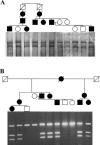Split-hand/split-foot malformation is caused by mutations in the p63 gene on 3q27
- PMID: 10839977
- PMCID: PMC1287102
- DOI: 10.1086/302972
Split-hand/split-foot malformation is caused by mutations in the p63 gene on 3q27
Abstract
Split-hand/split-foot malformation (SHFM), a limb malformation involving the central rays of the autopod and presenting with syndactyly, median clefts of the hands and feet, and aplasia and/or hypoplasia of the phalanges, metacarpals, and metatarsals, is phenotypically analogous to the naturally occurring murine Dactylaplasia mutant (Dac). Results of recent studies have shown that, in heterozygous Dac embryos, the central segment of the apical ectodermal ridge (AER) degenerates, leaving the anterior and posterior segments intact; this finding suggests that localized failure of ridge maintenance activity is the fundamental developmental defect in Dac and, by inference, in SHFM. Results of gene-targeting studies have demonstrated that p63, a homologue of the cell-cycle regulator TP53, plays a critically important role in regulation of the formation and differentiation of the AER. Two missense mutations, 724A-->G, which predicts amino acid substitution K194E, and 982T-->C, which predicts amino acid substitution R280C, were identified in exons 5 and 7, respectively, of the p63 gene in two families with SHFM. Two additional mutations (279R-->H and 304R-->Q) were identified in families with EEC (ectrodactyly, ectodermal dysplasia, and facial cleft) syndrome. All four mutations are found in exons that fall within the DNA-binding domain of p63. The two amino acids mutated in the families with SHFM appear to be primarily involved in maintenance of the overall structure of the domain, in contrast to the p63 mutations responsible for EEC syndrome, which reside in amino acid residues that directly interact with the DNA.
Figures





References
Electronic-Database Information
-
- GenBank, http://www.ncbi.nlm.nih.gov/Genbank/index.html (for the p63 gene [accession number BAA32593])
-
- Online Mendelian Inheritance in Man (OMIM), http://www.ncbi.nlm.nih.gov/Omim/ (for SHFM [MIM 183600], EEC [MIM 129900], AOS [MIM 100300], and focal dermal hypoplasia [MIM 305600])
References
-
- Boles RG, Pober BR, Gibson LH, Willis CR, McGrath J, Roberts DJ, Yang-Feng TL (1995) Deletion of chromosome 2q24-q31 causes characteristic digital anomalies. Am J Med Genet 55:155–160 - PubMed
-
- Celli J, Duijf P, Hamel BC, Bamshad M, Kramer B, Smits AP, Newbury-Ecob R, et al (1999) Heterozygous germline mutations in the p53 homolog p63 are the cause of EEC syndrome. Cell 99:143–153 - PubMed
-
- Chai CK (1981) Dactylaplasia in mice: a two-locus model for development anomalies. J Hered 72:234–237 - PubMed
-
- Cho Y, Gorina S, Jeffrey PD, Pavletich NP (1994) Crystal structure of a p53 tumor suppressor–DNA complex: understanding tumorigenic mutations. Science 265:346–355 - PubMed
-
- Crackower MA, Motoyama J, Tsui L-C (1998) Defect in the maintenance of the apical ectodermal ridge in the Dactylaplasia mouse. Dev Biol 201:78–89 - PubMed
Publication types
MeSH terms
Substances
LinkOut - more resources
Full Text Sources
Molecular Biology Databases
Research Materials
Miscellaneous

